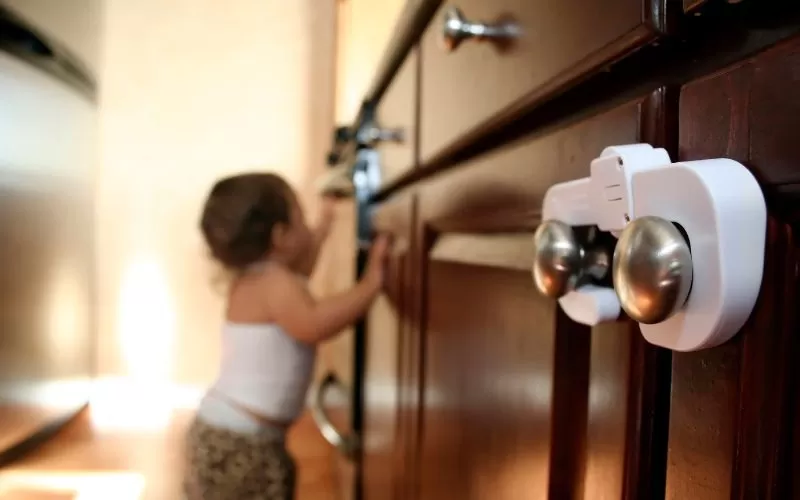Table of Contents
Childproof Your Home Tips
As your baby starts to grow and explore their surroundings, babyproofing your home becomes essential for ensuring their safety. Creating a safe environment can give you peace of mind while allowing your child to explore their new world. This guide will walk you through the steps on how to childproof your home systematically, room by room. We’ll also highlight some essential products from [your store] that can help make babyproofing easier and more effective.
As you begin to childproof your home, it’s essential to consider all potential hazards. The CDC provides comprehensive guidelines on child safety, including specific measures for baby-proofing your home. For in-depth tips and strategies to ensure your child’s safety, visit the CDC’s Learn the Signs. Act Early. initiative, which offers valuable resources for parents looking to protect their little ones from common household dangers.
Why Baby Proofing is Important

Before diving into the specifics, it’s essential to understand why babyproofing is crucial. Babies are naturally curious and often don’t understand danger. From sharp edges to electrical outlets, everyday household items can pose risks. By following a comprehensive plan, you can ensure that your home is a safe place for your child to grow and explore.
Babyproofing also offers parents peace of mind, allowing you to relax while knowing that your child’s environment is secure. From preventing falls to keeping harmful substances out of reach, babyproofing is a crucial step in creating a child-friendly home.
How to Baby-Proof the Nursery Effectively
The nursery is where your baby will spend most of their time, so it’s crucial to ensure this room is entirely safe. Start by securing heavy furniture, such as dressers and cribs, to the wall. Babies love to pull themselves up, and an unsecured dresser could topple over. Using safety straps, like the Anti-Tip Furniture Straps available at our store, will help prevent accidents.
Another important element in How to Baby-Proof the Nursery Effectively is to ensure that all electrical outlets are covered. Babies love to poke fingers into holes, and open outlets can be dangerous. You can use our Outlet Covers to safeguard those open electrical sockets. These prevent your little one from inserting objects into the sockets, drastically reducing the risk of electrical shocks.
Additionally, ensure that all cords, including blinds and curtains, are kept out of reach. Dangling cords can be a strangulation hazard, so it’s a good idea to invest in our Cord Wind-Ups to keep cords neatly wrapped and out of your baby’s grasp.
Tips for Nursery Safety:
- Secure furniture: Use anti-tip straps for dressers, bookshelves, and cribs.
- Cover outlets: Ensure all electrical outlets are safely covered.
- Remove choking hazards: Keep small objects like toys and decorative items out of reach.
Ensuring the nursery is properly baby-proofed provides a safe haven for your baby to sleep, play, and grow.
Babyproofing the House: A Checklist for Every Room
To create a truly safe home environment, every room in the house must be checked for potential hazards. Here’s a checklist that can guide you through the babyproofing process for each room:
Living Room
- Secure furniture: Use anti-tip straps on bookshelves and entertainment units.
- Cover sharp edges: Use corner guards on coffee tables and TV stands. Our Soft Edge Guards are perfect for reducing the risk of injury from sharp edges.
- Electrical safety: Ensure all outlets have covers, and wires are neatly tucked away. Cordless items or those with concealed wires are always a safer choice.
Kitchen
The kitchen poses multiple dangers for babies, so it’s important to be extra thorough here.
- Cabinet locks: Babies love exploring cabinets. Use Magnetic Cabinet Locks to prevent access to dangerous items such as cleaning supplies, knives, and small kitchen tools.
- Stove safety: Install stove knob covers to prevent little hands from turning the knobs. You can also use our Stove Guard to keep your baby from reaching hot surfaces.
- Secure small appliances: Make sure to place appliances like blenders or kettles out of reach, and unplug them when not in use. Appliances should also be pushed to the back of the counter to prevent tipping.
Bathroom
- Toilet locks: Babies love water, and the toilet can be a drowning hazard. Use toilet locks to keep the lid down.
- Non-slip mats: Install a non-slip mat in the bathtub to prevent slips and falls. Bathing can be a particularly hazardous time, so having a Non-Slip Bath Mat from our store is essential for your child’s safety.
- Store items safely: Keep medications, shampoos, and cleaning products in high cabinets or locked away. Use cabinet locks to secure any under-sink cabinets.
This Babyproofing the House: A Checklist for Every Room is crucial for ensuring no area in your home poses risks to your little one. Being thorough in this process can help you address potential dangers before they become problematic.
Guide To Baby-Proofing Your Home: Room by Room
When approaching babyproofing, it’s essential to think systematically. Every room has its unique set of hazards, and being thorough is key. Here’s a step-by-step Guide To Baby-Proofing Your Home, so you don’t miss anything:
Step 1: Identify Hazards
Start by walking through each room at your baby’s eye level. What do you see that could be dangerous? Look for sharp edges, loose wires, choking hazards, and potential fall risks. Kneeling or crawling around the room gives you the same perspective as your baby, allowing you to identify potential risks you might otherwise overlook.
Step 2: Prioritize High-Risk Areas
The kitchen, bathroom, and nursery tend to have the most significant risks. Focus on these areas first. Use baby gates, like the Adjustable Baby Gate, to block off rooms that are difficult to baby-proof entirely, such as the kitchen or laundry room.
Step 3: Install Safety Devices
Once you’ve identified the hazards, start installing the necessary safety devices. Products like outlet covers, cabinet locks, and anti-tip furniture straps should be installed immediately. Safety gates are essential for blocking access to stairs or dangerous rooms. Make sure to install our Top-of-Stair Baby Gate for added safety around staircases.
Step 4: Regularly Inspect and Update
As your baby grows, their ability to reach new things changes. Regularly inspect your babyproofing to ensure it remains effective. It’s a good idea to add extra measures as your child becomes more mobile.
How to Baby-Proof the Nursery Effectively: Final Touches
To further enhance your nursery’s safety, consider adding baby monitors and room thermometers. These devices give you extra peace of mind by allowing you to monitor your baby’s environment. Our store’s Digital Baby Monitor helps you keep an eye (and ear) on your baby while they sleep, ensuring they’re safe even when you’re in another room.
Additionally, place any toys or items your baby might use regularly within their reach to prevent them from trying to climb to grab them. Climbing is a major cause of accidents in nurseries, so keeping toys and essentials on lower shelves can help reduce this risk.
How to Baby-Proof the Nursery Effectively involves a mix of using smart safety devices and organizing the room to prevent unnecessary risks.
Maintaining a Safe Environment as Your Child Grows
Babyproofing is not a one-time task. As your baby grows and becomes more mobile, new hazards will emerge. For example, what might have been out of reach for a crawling baby could be easily accessible to a toddler who’s walking. It’s important to revisit each room every few months and reassess the safety measures you’ve put in place.
Additionally, certain safety devices may need to be replaced as your baby becomes stronger or more curious. Magnetic cabinet locks may need to be replaced with more secure options if your child learns how to unlock them. Baby gates may need to be adjusted as your baby grows taller.
By staying vigilant and proactive, you can ensure that your baby’s environment remains safe throughout their early years.
Common Mistakes to Avoid in Babyproofing
When babyproofing, it’s easy to overlook certain areas or make common mistakes. Here are some pitfalls to avoid:
- Not securing heavy furniture: This is one of the most important steps in babyproofing. Even if a piece of furniture seems stable, it’s worth securing it with anti-tip straps.
- Using subpar products: Make sure the safety products you use are of high quality. Cheaper alternatives might not provide the same level of protection. Be sure to shop for trusted products like our Outlet Covers and Magnetic Cabinet Locks.
- Not babyproofing early enough: It’s always better to start babyproofing before your baby becomes mobile. This gives you plenty of time to adjust your setup before they start crawling or walking.
Babyproofing the House: A Checklist for Every Room – Room-Specific Solutions
Each room presents unique challenges when babyproofing. Here are some room-specific solutions to consider:
- Living Room: Use foam edge guards on coffee tables and entertainment centers.
- Bathroom: Install a toilet lock and store cleaning supplies in a high, locked cabinet.
- Kitchen: Secure appliances and use stove guards to prevent burns.
This checklist will help guide you through each room, ensuring no area of your home is left vulnerable.
Conclusion: Babyproofing Your Home
Ensuring the safety of your baby as they grow and explore is essential for their well-being and your peace of mind. Babyproofing the house: A checklist for every room ensures that you systematically cover all potential hazards, while focusing on critical areas like the nursery, living room, and kitchen.

